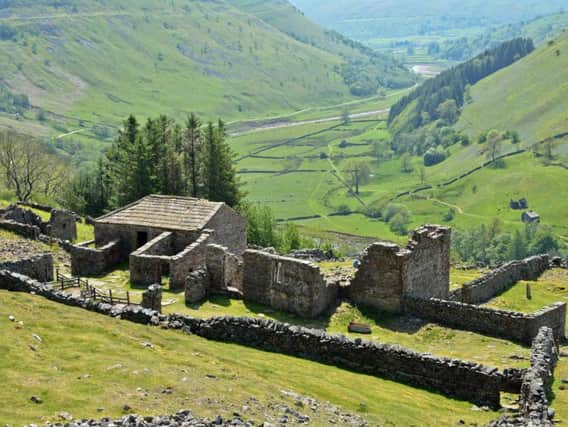Crackpot Hall: The Yorkshire ruins defined by the mystery of a feral child


Crackpot Hall, which overlooks Swinner Gill, near Keld, is now a ruin shrouded in its own myths and legends.
Its name - seemingly straight from a storybook - is actually derived from the Old Norse words for 'crow' and 'cave'; many of the underground caverns in the Dales are also known as Pot. An earlier 16th-century hunting lodge is thought to have stood on the site.
Advertisement
Hide AdAdvertisement
Hide AdNorton Conyers: The Yorkshire house that inspired Charlotte Bronte to write Jane EyreThe 18th-century smallholding was abandoned in 1953, when lead mining subsidence rendered it uninhabitable. It's thought that the building may also have been used as offices for the mining companies in the area.


Archaeologists have discovered the remains of bottles, candles and even dynamite wrapped in a newspaper from 1893 that the old lead miners had left behind.
Walkers can step inside the crumbling house, which still has the old range and a rusty tin bath that the last owners abandoned.
A strange tale
In the 1930s, residents of the dale were captivated by an unsettling story which emerged from the valley.
Advertisement
Hide AdAdvertisement
Hide AdFalling Foss: The enchanted Yorkshire tea garden that is one of Yorkshire's quirkiest cafesTwo well-known authors who published books on the social history of the Dales, Ella Pontefract and Marie Hartley, wrote about a four-year-old girl named Alice who had reportedly been discovered roaming 'wild' and barefoot near the hall, and the legend of the feral child soon spread. They claimed her speech and dialect were difficult to understand.
Ella and Marie were from wealthy West Riding mill-owning families who came to love walking in the Dales. They bought a property in Askrigg that they lived in during World War Two before Ella's sudden death at the age of 48. Marie died in 2006 at the age of 100.
Their discovery of 'Alice' drew parallels to the story of Alice in Wonderland - Ella and Marie were known for their child-like imaginations.
The myth persisted over the decades, until in 2015 a BBC radio documentary investigated the story. They researched the local folklore and established that Alice was one of the children who lived at Crackpot Hall at the time, along with her five siblings. She roamed freely around the farm.
Advertisement
Hide AdAdvertisement
Hide AdPresenter and children's author David Almond managed to uncover photographs of Alice with her parents, brothers and sisters, and even the family sheepdog in the 1930s - and she looked distinctly un-feral in the images, including one taken on the day she met authors Ella and Marie.
Alice is found again
His most intriguing discovery was that Alice Harker was still alive and in her 80s - he tracked her down to Carlisle, where she was living, and met her to reminisce about her wild childhood in Swaledale and her longing to return. She spoke at length about her memories of the day she met the writers who were to immortalise her.
Rievaulx Terrace in North Yorkshire named one of Britain's best 'secret spots'Alice remembered the isolation of living at Crackpot and her family's 'wild ways'. She was the last of the siblings - the others were Dorothy, Martha, Stanley, Raymond and Nathaniel - still living.
She was tracked down via a 2002 newspaper obituary for one of her brothers, a sheep farmer who had grown up at Crackpot - the hard evidence that proved a child called Alice really had existed.
Advertisement
Hide AdAdvertisement
Hide AdAlice was in her early 20s when her parents decided to move to a new farm near Hawes with more productive land. A shepherd replaced them in the house, but he was to be the final occupant.
Today, Crackpot is part of the Gunnerside Estate, who have committed to preserving the scenic ruin.